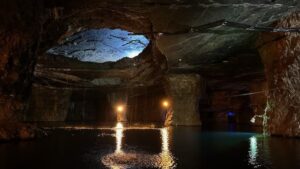
I recently took my family about an hour south of St. Louis to Bonne Terre, Missouri, for a tour of the town’s famous mine. This was a working lead mine from 1860 to 1962, but now it’s just different levels of massive open spaces where the lead used to be. In fact, it’s the largest man-made cavern in the world, and much of it was carved out before power tools were even invented.
Our guide told us a few stories, including that in its earliest days, no one knew about the dangers of being exposed to lead. There was no OSHA, so the miners worked with no masks and no gloves. The latter exacerbated the risk because when it was time for a lunch break, the men didn’t leave the mine. They just sat down, opened up their lunch boxes, and ate whatever food they’d brought — with their hands. There’s nothing like a bologna sandwich with a hefty dose of lead dust.
The mine opened in 1860, which led me to wonder whether it had trouble keeping enough men on the job over the next few years since so many of them went off to fight in the Civil War. Nearly 60% of male Missourians fought in the war — 109,000 on the Union side and 30,000 for the Confederacy. Yet the mine stayed open, and once the war was over, there were so many men working down there it had its own tool shop, post office, and barbershop.
One of the coolest things about the Bonne Terre Mine is the billion-gallon lake at the bottom, the largest subterranean body of water on Earth. Fed by springs and rainwater, the lake is about 100′ deep, many miles wide, and crystal clear. The company that owns the mine has installed lights at various depths so we could see right down to the bottom. The lights are actually there to help scuba divers — a nice side business that attracts people from all over.
It’s been over 30 years since I went on a dive, so I can only imagine what it’s like to swim through the various flooded rooms and see relics like old ore carts (which were pulled by donkeys back in the day), other mining equipment, and the elevator shaft that was used to bring the loads of lead up to the surface. The best I could do now was join the other tourists in a 10-minute ride on a pontoon boat that’s moored at a wooden dock on the edge of the lake, where divers store their scuba tanks, flippers, weights and other gear.
Afterwards, our group walked up the same way we went down — which was not nearly as much fun. When we re-emerged, we quickly discovered that the town of Bonne Terre doesn’t have much to offer above ground. Certainly nothing to rival the lore of that big empty space under the surface.
